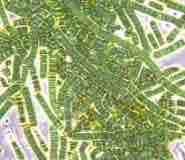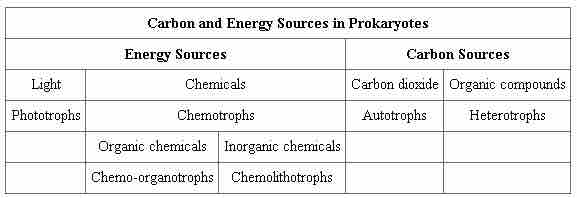Needs of Prokaryotes
The diverse environments and ecosystems on Earth have a wide range of conditions in terms of temperature, available nutrients, acidity, salinity, and energy sources. Prokaryotes are very well equipped to make their living out of a vast array of nutrients and conditions. To live, prokaryotes need a source of energy, a source of carbon, and some additional nutrients.
Macronutrients
Cells are essentially a well-organized assemblage of macromolecules and water. Recall that macromolecules are produced by the polymerization of smaller units called monomers. For cells to build all of the molecules required to sustain life, they need certain substances, collectively called nutrients. When prokaryotes grow in nature, they obtain their nutrients from the environment. Nutrients that are required in large amounts are called macronutrients, whereas those required in smaller or trace amounts are called micronutrients. Just a handful of elements are considered macronutrients: carbon, hydrogen, oxygen, nitrogen, phosphorus, and sulfur. (A mnemonic for remembering these elements is the acronym CHONPS. )
Why are these macronutrients needed in large amounts? They are the components of organic compounds in cells. Carbon is the major element in all macromolecules: carbohydrates, proteins, nucleic acids, lipids, and many other compounds. Carbon accounts for about 50 percent of the composition of the cell. Nitrogen represents 12 percent of the total dry weight of a typical cell and is a component of proteins, nucleic acids, and other cell constituents. Most of the nitrogen available in nature is either atmospheric nitrogen (N2) or another inorganic form. Diatomic (N2) nitrogen, however, can be converted into an organic form only by certain organisms, called nitrogen-fixing organisms. Both hydrogen and oxygen are part of many organic compounds and of water. Phosphorus is required by all organisms for the synthesis of nucleotides and phospholipids. Sulfur is part of the structure of some amino acids such as cysteine and methionine. It is also present in several vitamins and coenzymes. Other important macronutrients are potassium (K), magnesium (Mg), calcium (Ca), and sodium (Na). Although these elements are required in smaller amounts, they are very important for the structure and function of the prokaryotic cell.
Micronutrients
In addition to these macronutrients, prokaryotes require various metallic elements in small amounts. These are referred to as micronutrients or trace elements. For example, iron is necessary for the function of the cytochromes involved in electron-transport reactions. Some prokaryotes require other elements (such as boron (B), chromium (Cr), and manganese (Mn)) primarily as enzyme cofactors.
The Ways in Which Prokaryotes Obtain Energy
Prokaryotes can use different sources of energy to assemble macromolecules from smaller molecules. Phototrophs (or phototrophic organisms) obtain their energy from sunlight . Chemotrophs (or chemosynthetic organisms) obtain their energy from chemical compounds. Chemotrophs that can use organic compounds as energy sources are called chemoorganotrophs. Those that can also use inorganic compounds as energy sources are called chemolithotrophs.

Filaments of photosynthetic cyanobacteria
Cyanobacteria are an example of phototrophic prokaryotes.
The Ways in Which Prokaryotes Obtain Carbon
Just as prokaryotes can use different sources of energy, they can also utilize different sources of carbon compounds. Recall that organisms that are able to fix inorganic carbon are called autotrophs. Autotrophic prokaryotes synthesize organic molecules from carbon dioxide. In contrast, heterotrophic prokaryotes obtain carbon from organic compounds. To make the picture more complex, the terms that describe how prokaryotes obtain energy and carbon can be combined. Thus, photoautotrophs use energy from sunlight and carbon from carbon dioxide and water, whereas chemoheterotrophs obtain energy and carbon from an organic chemical source. Chemolithoautotrophs obtain their energy from inorganic compounds, while building their complex molecules from carbon dioxide. Table 1 summarizes carbon and energy sources in prokaryotes .

Table 1. Carbon and energy sources in prokaryotes
This table summarizes the types of energy and carbon sources for different types of prokaryotes.